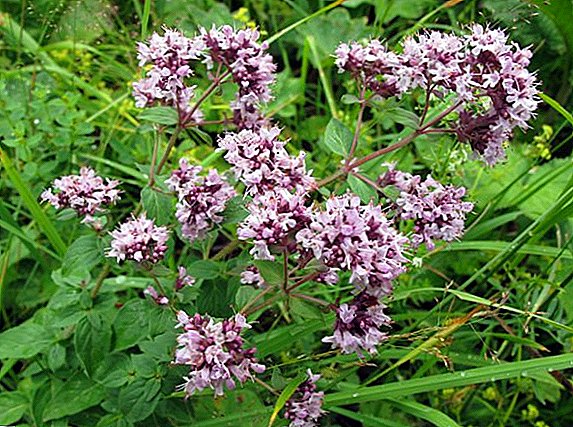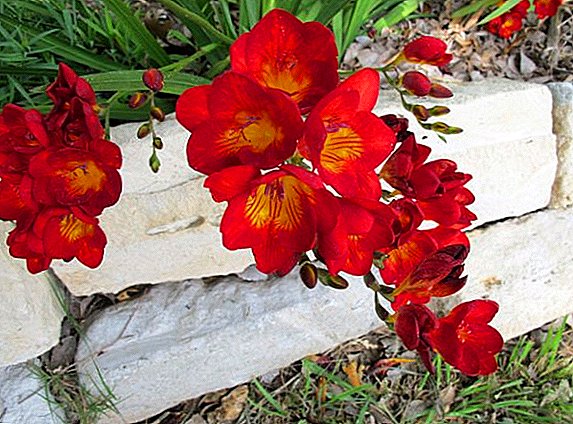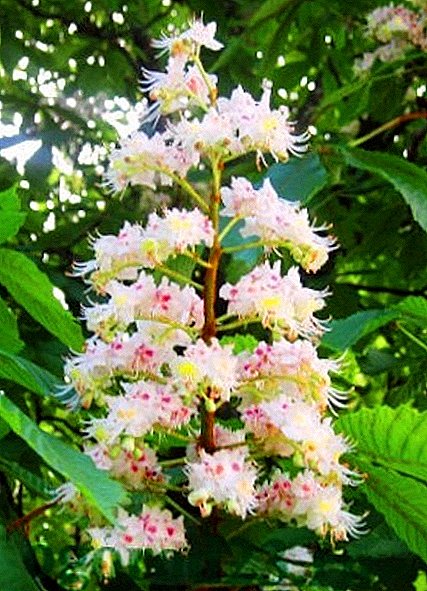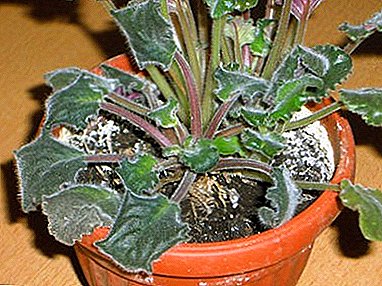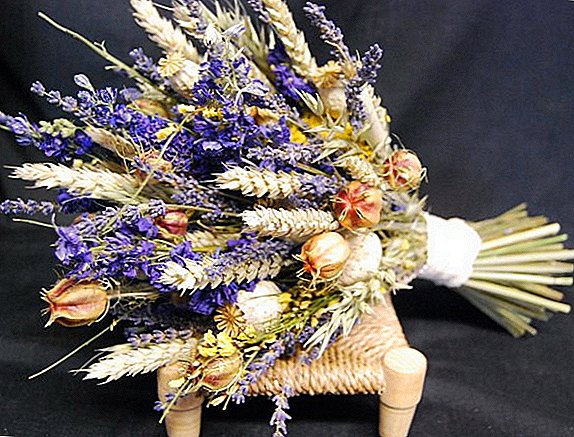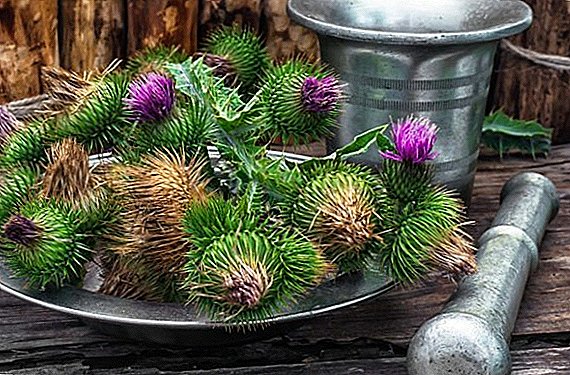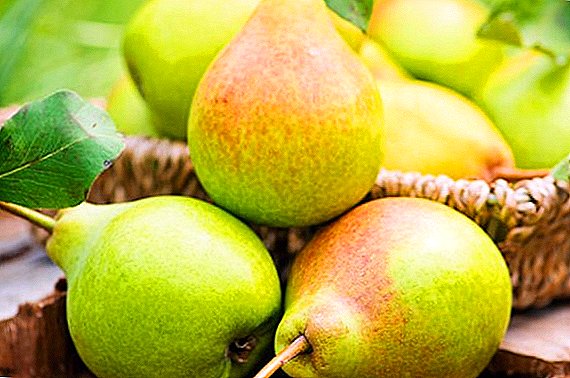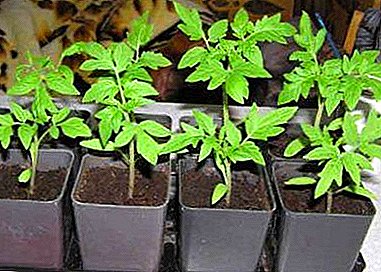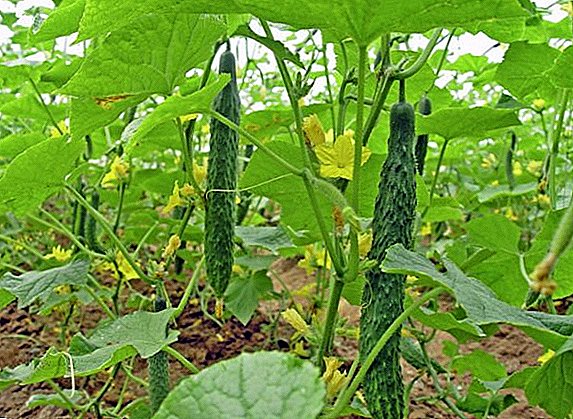 "Chinese miracle" - a variety of cucumbers that can turn the idea of this seemingly ordinary vegetable. Unnaturally large fruits attract attention for their size. But a large vegetative mass requires appropriate care. How to grow on your site a giant native of the Middle Kingdom and care for him - we will tell in our article.
"Chinese miracle" - a variety of cucumbers that can turn the idea of this seemingly ordinary vegetable. Unnaturally large fruits attract attention for their size. But a large vegetative mass requires appropriate care. How to grow on your site a giant native of the Middle Kingdom and care for him - we will tell in our article.
Variety description
"Chinese miracle" - a variety belonging to a separate variety of cucumbers, united by the common name "Chinese". Among other varieties, this is distinguished by the size of its fruit - 0.4-0.6 m in length. Zelentsy have the correct cylindrical shape and a small amount of thorns. The flesh of such a miracle is not bitter, but it is very juicy, and when you bite a pronounced crunch is felt, the seeds are quite small.
Check out the most unusual varieties of cucumbers.
The lash can be very long, so the garter is necessary for the plant. The root system is quite strong and developed compared to other varieties. With the required amount of light and sufficient watering, the cucumber will fully delight you with its fertility, resistance to diseases and pests and fairly moderate requirements for care.  Many varieties belonging to the Chinese types are eaten only fresh. The difference of the “Chinese miracle” from its close relatives is that it can be salted or preserved.
Many varieties belonging to the Chinese types are eaten only fresh. The difference of the “Chinese miracle” from its close relatives is that it can be salted or preserved.
Important! the main feature "Chinese miracle" consists in the fact that half of the growing fruit can be cut off, the rest will be quite normal to continue to grow.The advantages of the variety:
- high yield;
- fruits look attractive;
- high disease resistance, resistance to pests and weather conditions;
- can be consumed not only raw, but also canned (salted);
- Zelentsy have excellent taste (do not be bitter), do not turn yellow, do not have empty cavities, small size of seeds.
- keep a trade dress no more than a day, during this time they must be consumed;
- require mandatory good garters (due to the size of the green mass, the size of the fruit and the length of the plant), often 2-4 times per season.
Fruit characteristics and yield
 "Chinese miracle" refers to the late varieties, but it compensates for this circumstance by a very high yield.
"Chinese miracle" refers to the late varieties, but it compensates for this circumstance by a very high yield.
- Landing in the ground - April-May.
- The ripening period is 60-75 days.
- The height of the whip is 1 m and higher (if not cut, it grows to 3.5-4 m).
- Recommended planting density - 1 plant / sq. meter.
- The fruits ripen from July to September. One whip can bring up to 25-30 kg of greens per season.
- Length / weight of the fetus - 45-60 cm / 0.4-1 kg.
Did you know? The Russian-language name "cucumber" is of ancient Greek origin, where the fruit was called "Aguros" - "unripe, immature".
Selection of seedlings
If you prefer a seedling method of planting, and decided to purchase seedlings on the market, you should carefully consider its choice. The quality of planting material depends largely on what kind of harvest you will collect.  Buying seedlings on the market is a rather risky process, if, of course, you do not have a familiar gardener who professionally breeds it. Therefore, before you go for the seedlings, familiarize yourself with some simple rules:
Buying seedlings on the market is a rather risky process, if, of course, you do not have a familiar gardener who professionally breeds it. Therefore, before you go for the seedlings, familiarize yourself with some simple rules:
- The best age of seedlings for planting it in the ground - 4 weeks.
- The stem should look strong and healthy, there should be no dry spots on it.
- The variety has a fairly powerful root system, for the normal functioning of which the plant must be in the substrate, and the roots themselves look fresh and healthy.
- The optimal seedling for planting in the ground should look like this: height - 37-43 cm, 4-6 true leaves, the lower leaves by the time of planting should already be about 8-9 cm long. For the rest, the shoot should outwardly correspond approximately to the description in the previous paragraphs. If you find such a seedling, you think you are very lucky.
Important! All Chinese cucumbers are parthenocarpic type, that is, they are pollinated independently.
VIDEO: HOW TO CHOOSE THE BEST CROWN
Soil and fertilizer
Soils with high humus content and neutral pH are most suitable for this variety. Clay soil or damp places with close groundwater storage is generally contraindicated for Chinese cucumber.
The ideal can be called such a composition of the soil:
- turf - 1/4;
- peat - 3/8;
- humus - 3/8.
- Those areas where any pumpkin plants used to grow should not even be taken into account, as potential beds, cucumbers sprout on them extremely badly.
- But any cucumbers, including Chinese ones, feel great when planted on the site where tomatoes and cabbage used to grow, and it is quite acceptable where radishes, beets and carrots grew.
 First you need to dig up the future beds. The cut is not less than 30 cm, this mixture is brought to this depth (based on 1 sq. M):
First you need to dig up the future beds. The cut is not less than 30 cm, this mixture is brought to this depth (based on 1 sq. M):
- rotted mullein or humus - 20 liters;
- sawdust - 5 l;
- wood ash - 50 g;
- potassium sulfate - 10 g;
- superphosphate - 50 g;
- urea - 10 g
Before making fertilizer, sawdust should be soaked in ammonium nitrate solution (40 g per 20 l of water) and dried for 2 weeks. There is a simpler way of autumn fertilizer. After digging, identify future beds, dig out ditches wide by one bayonet and 0.5 m deep between them. Fill the grooves for 2/3 with a mullein, cover it from above with earth. In the place of these covered trenches there will be inter-rows.
VIDEO: HOW TO PREPARE AND APPLY COW
Growing conditions
The “Chinese miracle” is a rather unpretentious variety, however, when growing it, it is worth remembering some important points:
- Humus soils with neutral acidity - the best option for the "Chinese", clay and marshy ground is not suitable.
- Re-planting culture in the same place should be no earlier than the sixth year.
- Soil temperature not less than + 15 ° С.
- Air temperature - + 20-27 ° С.
- Abundantly watered 1-2 times a week, after the procedure it is necessary to well gnaw the ground.
- Mandatory use of garter.
- Moderately heavy fertilizing with potassium fertilizers.
- A place for beds should be, if possible, isolated from drafts and well lit.
Did you know? In the botanical classification, the fruit of the plant cucumber is called pumpkin. The same name have the fruits of pumpkin, squash, zucchini, watermelon.
Growing from seed to seedlings at home
In the south of Russia and almost the entire territory of Ukraine, the “Chinese miracle” can be grown with seeds, planting them in open ground or in a greenhouse. But still, the seedling method is more popular in our latitudes.  The approximate time to start the process of germinating seeds - the second half of March-early April. A more accurate date can be found out as follows: it is necessary to plant seedlings in open ground when the thermometer will be stably in the area of + 18-20 ° С during the day. By this time, your seedlings should look as described above (stem length - 40-45 cm, 4-5 leaves, etc.). That is, the seeds for seedlings need to be sown about 1 month before the expected date of planting in the ground.
The approximate time to start the process of germinating seeds - the second half of March-early April. A more accurate date can be found out as follows: it is necessary to plant seedlings in open ground when the thermometer will be stably in the area of + 18-20 ° С during the day. By this time, your seedlings should look as described above (stem length - 40-45 cm, 4-5 leaves, etc.). That is, the seeds for seedlings need to be sown about 1 month before the expected date of planting in the ground.
Check out other varieties of Chinese cucumbers.
Seed preparation
Seed preparation for sowing should begin with the calibration and rejection of empty. The optimal size of the seed is 3-5 mm wide and 7-9 mm long. Very large seeds are often empty, and too small seeds will give the same seedlings.
Pour the seeds into a glass and fill them with cool water. After a quarter of an hour, those seeds that remain on the surface of the water can be thrown away, since they are hollow.
The next step is the preplant treatment of seeds with antiseptics and growth stimulants. There are enough means of industrial production designed for these purposes, but you can use the improvised:
- soak in a solution of potassium permanganate (1 g per 100 ml of water) for a quarter of an hour;
- soak overnight in soda solution (1 g of soda per 200 ml of water), the agent has not only aseptic qualities, but also a catalyst for seed germination;
- You can use the tool "Fitosporin".
 To stimulate the growth of such drugs are used:
To stimulate the growth of such drugs are used:
- soaked for 2.5 hours in sodium humate (1 g of humate is poured over with 2 liters of water);
- soaked overnight in a solution of the drug "Epin" (8 drops to 2 liters of water).
- Dampen a small kitchen towel with water, wrap the seeds in it and put it in the fridge.
- After one day, remove the seeds and place them in an area with elevated temperature (warm battery, near a gas or electric stove, etc.).
When the seeds are disinfected, treated with growth stimulant and hardened, you can proceed to their germination.
Important! Difficulties may arise with the acquisition of potassium permanganate for aseptic processing of seeds. It can be replaced with streptomycin (25 g per 0.5 l). In the resulting solution, the seeds are soaked for 24 hours, then rinsed well with running water.
Content and locations
The best place for seedlings is windowsill. The temperature should fluctuate around 22-25 ° С. For seed germination, it is preferable to use peat pots; in extreme cases, plastic cups (0.5 l) with drain holes made in the bottom are suitable. 
Learn how to choose the right pots for seedlings and how to disinfect the ground before planting seedlings.
Seed planting process
To start, you should prepare the soil mixture for seedlings. You can, of course, buy ready-made soil, and you can use the substrate of its own production. There are many recipes for preparing a mixture, we will tell about some of them:
- humus - 4 parts;
- fertile turf - 1 part.
Another recipe for seedlings: peat, humus, turf, leaf litter mixed in equal proportions. Opad is well sprinkled with boiling water before use.
The finished soil mixture, even in the case when it is purchased in the store, must be calcined in the oven (15 minutes at t + 190-210 ° C), and can be treated with boiling water with the addition of potassium permanganate (1 tsp per 10 liters of water) . If you decide to resort to the second method, it should be done taking into account the time required for the soil to dry out after a heavy strait with water (2-3 days).
- The pots (cups) are filled with the substrate, and they are watered for 2-3 days so that at the time of sowing the soil is moderately moistened.
- On the surface of the soil, in the center, with a finger, a hole is made 1-1.5 cm deep.
- Put prepared seed in the hole, cover it with substrate and cover the pot with film.



The best temperature for germinating seeds is 26-31 ° C. It should also every day, starting from the third day, for 5-10 minutes to remove the film. At the initial stage, temperature is of greater importance, when the first shoots appear, lighting will play an equally important role. As soon as green shoots erupt, the film is removed completely.
Did you know? "Lifent Senius", "Lno-Min" and "Min-Sintyay" - traditional Chinese cucumber varieties, by crossing which Russian breeders managed to bring the variety "Chinese miracle".
Seedling care
After the first shoots appear, the air temperature should be reduced to + 22-26 ° С. If the room is hot, it is necessary to periodically air the room. Proper moistening, sufficient amount of light and optimum temperature - these are the components for the successful cultivation of seedlings.
If the air temperature in the room is low, it is worth to use fitolamps or fan-type heaters ("wind blowers"). Phytolamps are preferable because, together with heating, they provide good lighting, so necessary for plants.
Watering of seedlings should be separated by water, with a temperature not lower than + 26 ° C. It is necessary to control that the substrate is constantly in a state of light (not excessive!) Moisture.  In the event that the soil is dry, moisten it with a sprinkler, if it is too wet - do not water it for a while, put a glass with a seedling in a warm place, so the excess moisture will evaporate soon.
In the event that the soil is dry, moisten it with a sprinkler, if it is too wet - do not water it for a while, put a glass with a seedling in a warm place, so the excess moisture will evaporate soon.
We should not forget about the hardening of young shoots. "Chinese miracle" refers to the late varieties, you will sow seeds for seedlings no earlier than mid-April. At the end of April and the beginning of May, the weather usually accompanies air procedures.
The main condition is the absence of wind. On a fine sunny day, open the windows of the window sill, on which your seedlings are standing, you can take to the balcony or the street. It should start with a 5-7-minute session, gradually increasing the time spent in the fresh air. Such an adaptation has a positive effect on plants.
As the seedlings begin to stretch, their roots may become bare. To avoid this, you should pour the substrate into the pots. After the appearance of the first real leaf shoots need to feed. For fertilizing, you can buy fertilizer in the store, and you can do it yourself:
After the appearance of the first real leaf shoots need to feed. For fertilizing, you can buy fertilizer in the store, and you can do it yourself:
- separated water - 2 l;
- bird droppings - 30 g;
- simple superphosphate - 3 g;
- ammonium nitrate - 1 g.
Transplanting seedlings to ground
The main condition for planting seedlings in the ground:
- The daily air temperature is at least + 18-20 ° С, at night so that it does not fall below + 13 ° С.
- Soil temperature is not lower than + 15 ° С.
Important! If your seedlings are ready for planting, and the necessary weather conditions have not yet been established, reduce watering and temperature at the place of cultivation to a minimum.If the weather conditions meet the requirements, you can begin transplanting in a greenhouse or open ground. Land for planting should be prepared in the autumn as it was mentioned above.
The beds themselves are filled with shafts about 0.3 m in height, and 0.8 m in width between the rows. It is best to plant the plants in a staggered manner, so they will get more sunlight and be more compact.  The “Chinese” have very few lateral shoots, so that young shoots can be planted close enough: 0.3 m between adjacent lashes is quite an acceptable distance.
The “Chinese” have very few lateral shoots, so that young shoots can be planted close enough: 0.3 m between adjacent lashes is quite an acceptable distance.
- 10 days before the intended landing on the crest of the shaft dig a narrow trench 20 cm deep. At the bottom of the groove lay a layer of mullein (3-5 cm) and cover with earth. The beds themselves are covered with foil. Thus, by the time of planting the land warms up quite well.
- 2 days before planting, dig holes, so that the pot was free to enter them.
- The wells are first spilled with a strong solution of potassium permanganate in boiling water. After the potassium permanganate is absorbed, the well is poured with plain water. When the water is gone, put a little compost on the bottom of the hole.
- From the evening before planting, the seedlings are watered so that they can be freely removed from the pot.
- Carefully remove the plant from the glass (if you use a peat pot, the seedling in the hole is placed with it). This should be done so that the substrate surrounding the roots remains maximally intact.
- The seedling is placed in such a way that the root neck is located 20 mm above the edge of the hole.
- When all the seedlings are planted, the soil is rammed, pour the seedlings with warm water (+ 27-30 ° C), and mulch the ground with straw or sawdust. Mulch will not allow moisture to evaporate quickly and will contribute to the retention of heat in the root zone.

Did you know? Potassium, vitamins A and K, all B vitamins, vitamin C, folic acid, iron, antioxidants - This is not a complete list of vitamins and minerals contained in cucumbers. Vitamin K helps to increase bone strength.
Agrotechnics growing seeds in open ground
The seedless method of growing the “Chinese miracle” is quite suitable for the south of Russia and the whole territory of Ukraine. With this method of planting the plant will begin to bear fruit later than its counterparts grown seedlings. But it will take longer to delight you with the harvest.
Moreover, thanks to this method, cucumbers grow more adapted to weather conditions and have natural immunity from diseases and pests.
Outdoor conditions
It is possible to sow with seeds both in an open ground, and in the greenhouse. Approximate planting time - the end of April-early May. The soil under the beds and seeds for planting is prepared in the same way as it is done for planting seedlings.
Look at the place that meets the requirements of the plant (sufficient illumination, but without direct sunlight and protection from drafts). If the acidity of the earth is higher than the desired neutral one, add chalk or slaked lime from autumn, you can use ready-made alkaline organic fertilizers.
The process of planting seeds in the ground
 By the time the seeds are planted, the ground should warm up to no less than 15 ° C. The soil is heated to this temperature around the beginning of May. By this time, your seeds should be picked, disinfected and hardened.
By the time the seeds are planted, the ground should warm up to no less than 15 ° C. The soil is heated to this temperature around the beginning of May. By this time, your seeds should be picked, disinfected and hardened.
- In prepared fertilized beds we mark the location of future plants, just as if we were planting seedlings. The only difference is that we will not make holes, but small holes with a finger, 2-2.5 cm deep.
- The distance between the pits - 25 cm, aisle - 80 cm.In each hole, we put 2 seeds, covered with earth. At a distance of 5-7 cm from each pit, you can stick a beacon stick.
- After the pits are filled, pour warm water (+ 27-30 ° C) with water.
Watering
"The Chinese" need abundant watering. It is necessary to carry out the procedure 2-3 times a week, if the weather is arid, in the case of periodic precipitation weekly irrigation will be sufficient.
We recommend to learn how to grow cucumbers in non-standard ways: in buckets, bags, barrels, using hydroponics.
Watered with settled, and better, rainwater, temperature + 24-26 ° C. Watering is necessary in such a way that water does not fall on the leaves, only in the root area.
For a young plant will be enough 2-4 liters per shoot. When the whips grow up, a one-time irrigation should be about 7-9 liters per square. m. During flowering and fruiting volume increased to 18-30 liters per square meter. m. Do not use for irrigation hose and tap water.  Watering is best done using a watering can. This should be done in the morning, before the appearance of direct sunlight, or in the evening, when the sun is drooping. Suitable also drip irrigation type.
Watering is best done using a watering can. This should be done in the morning, before the appearance of direct sunlight, or in the evening, when the sun is drooping. Suitable also drip irrigation type.
Soil loosening and weeding
Although the "Chinese miracle" has more powerful roots, compared to other varieties of cucumbers, but still we must be very careful with weeding. It is necessary to loosen the ground after each irrigation so that a crust does not form, 3-4 times per season, weed between rows and the beds themselves.
Important! For normal growth "Chinese miracle" a proper, strong enough garter is needed. You may have to change it. 2-3 times during the fruiting season.
Masking
“Chinese miracle” is a variety that does not require pasyncratization. The reason for this - the dominant female type of flowering, as well as the almost complete absence of the plant lateral shoots.
Garter
But the garter for this variety is vital. A large growing mass requires support; it’s almost impossible to cope with its own weight. In addition, tied plants have significant advantages:
- Plants grow compactly, not taking up much space.
- With a tied whip it is easier to harvest.
- Fruits lying on the ground quickly deteriorate, the leaves and stems can become ill, or be attacked by parasites.
- Garter contributes to the appearance of ovaries, that is, increases productivity.
- Garter helps to increase the amount of sunlight received by the fruit.
Garter should be done shortly after the plant reaches 0.5-0.6 m in length. An individual garter is best suited for this variety. But you can apply and trellis.  Side racks need to be installed before you plant seedlings or seeds in the ground. And if you decide to make an individual garter for each lash, then the vertical posts should be installed in advance. This is done in order not to damage the root system.
Side racks need to be installed before you plant seedlings or seeds in the ground. And if you decide to make an individual garter for each lash, then the vertical posts should be installed in advance. This is done in order not to damage the root system.
There are 4 basic ways to garter:
- horizontal;
- vertical;
- hybrid;
- wall
- Vertical. The supports are installed at the beginning and at the end of the bed, between them, at a height of about 2 m, the rope is stretched. Falling down tails are tied to a horizontal rope, according to the number of lashes. To each "tail" tie up one lash.
- Wall. The supports are installed similarly to the previous method. Between them they stretch a large-mesh garden mesh, or they make a mesh of wire or window slats.

Find out what advantages the trellis grid for cucumbers has and how to install it correctly.

Did you know? In the UK, cultivated a variety whose fruits exceed the length "Chinese miracle". Such cucumbers do not have seeds that increase the formation of gases in the intestines.
Top dressing
In that case, if the preliminary work on the preparation of the beds were carried out correctly in the autumn, in the spring you can only use organic matter: ash (60 g / sq. M), mullein or chicken manure. Litter must be dissolved in water in a ratio of 1: 3, let stand for 3-5 days. The product must be well stirred and then diluted in water (1:15). Use the resulting fertilizer for irrigation.
If the preparation of the beds in the fall was cut, you should use mineral fertilizers. You need to make them according to this scheme:
- Nitrofoska - diluted in 20 l 2 tbsp. spoons. After the appearance of the first two leaves, each lash is watered with 2 liters of product. Carry out the procedure after normal watering.
- Potassium Sulphate - dilute in 20 l 2 tsp. Apply the first time after the appearance of the third leaf (2 liters per 1 plant), the second time - after 20 days.
- Urea - 20 g diluted in 5 liters of water. When the ovaries appear, spray the foliage. It is necessary to carry out the procedure in the evening.
- "Master 20.20.20" - 40 g of the drug dissolved in 20 liters of water. After a dozen leaves grow on the scourge, add 1.5 l of funds to each bush. Then, 1 time in 2 weeks, until the plant blooms.
- Shortly before flowering and immediately after the appearance of the first fruits, Azogran or Vermistim are used. It is necessary to strictly follow the instructions, otherwise you can damage the root system.
Pests, diseases and prevention
Mealy dew. Characteristic features are a pale deposit on the underside of the leaf, similar to salt left over from salt water. In the late stage, the raid moves to the front side, becomes dark. For the treatment used "Oxyh": 5 g of the drug is dissolved in 2.5 liters of water. Spray thoroughly in the evening, repeat the procedure after 2 weeks.
Learn how to deal with powdery mildew on cucumbers.
 Downy mildew. Spots of yellow color in the form of circles, which are subsequently covered with a dark blob of brown or red-blue hue. Use the drug "Topaz". In 10 liters of water dilute 1 ampoule. Spray the foliage at intervals of 10 days.
Downy mildew. Spots of yellow color in the form of circles, which are subsequently covered with a dark blob of brown or red-blue hue. Use the drug "Topaz". In 10 liters of water dilute 1 ampoule. Spray the foliage at intervals of 10 days. 
Downy mildew is one of the most common diseases of cucumbers.
Alternaria At the bottom of the leaves are affected small beige sores, which increase in size and in number, combining into a single large area of destruction. Used for the treatment of "Ridomil Gold". 5 liters of water 25 g of the drug. Evening spraying 1 time in 10-12 days.  Anthracnose. The stem is covered with brown longitudinal grooves, the leaves - the same color, stained. In a fairly short time rot Zelentsy. For treatment, they use Oxyh, in the same way as in the treatment of powdery mildew.
Anthracnose. The stem is covered with brown longitudinal grooves, the leaves - the same color, stained. In a fairly short time rot Zelentsy. For treatment, they use Oxyh, in the same way as in the treatment of powdery mildew.  Aphid. The most common parasite that lives on cucumbers. The plants on which the aphids started up quickly wither, the ovaries fall off, respectively, the fruits on such a whip are no longer formed.
Aphid. The most common parasite that lives on cucumbers. The plants on which the aphids started up quickly wither, the ovaries fall off, respectively, the fruits on such a whip are no longer formed. 
We recommend to learn how to protect cucumbers from aphids.
Miners When the first fruits ripen, this parasite may also appear. In both cases, the plants are sprayed with the drug "Fitoverm" (10 ml per 2 liters of water). After 12-14 days, the procedure is repeated.  In order to try to minimize the risk of infection by various diseases and to protect against parasites, you need to follow some recommendations:
In order to try to minimize the risk of infection by various diseases and to protect against parasites, you need to follow some recommendations:
- Do not use a lot of nitrogen in fertilizers.
- When landing, maintain a sufficient distance between the lashes so that the flow of air is not impeded.
- If you grow cucumbers in a greenhouse, monitor the humidity of the air. Check all corners and joints for drafts.
- Contact the plant very carefully, try not to damage it. Any scratch can be a weak point where the infection falls.
Important! For seedlings with seedlings when sprouting cucumber seeds, the soil from the beds where the tomatoes grew is well suited.
Harvesting and storage
Harvesting is best done daily. When collecting, use a knife or pruner, no need to pick and unscrew the fruit. After harvesting, you can water the plants.
The variety "Chinese miracle" quickly deteriorates, for this reason it should be eaten in the first days after harvest. Greenhouse greenhouses can be stored for about 1 week at t + 10-12 ° С, for example, groundwater requires lower (+ 7-9 ° С) temperature and humidity at this level at the level of 90%.  At a temperature of 0 ... + 4 ° C, fruits are stored even longer, but they lose their taste.
At a temperature of 0 ... + 4 ° C, fruits are stored even longer, but they lose their taste.
Learn how to preserve cucumbers for the winter.
Possible problems and recommendations
If you decide to plant cucumbers without growing seedlings, you will need more seeds than with the seedling method. The variety has a very large vegetative mass, therefore, requires high-quality feeding. And although the "Chinese" can not be called too capricious and demanding variety, some rules should be remembered:
- The “Chinese miracle” is very sensitive to soil moisture. The soil should always be sufficiently moist.
- Pay special attention to garter lashes.
- In no case should not neglect dressing. For such a giant, it is vital.
Did you know? In cucumbers in fairly considerable quantities contain lignans - substances that are believed to reduce the risk of some cancers.
 When growing, there may be some characteristic problems:
When growing, there may be some characteristic problems:
- The leaves turn yellow and showered. Such a circumstance may be due to improper watering.
- The green mass may turn yellow due to lack of air in the soil, which leaves due to high moisture, and not enough loosening (or its absence).
- Improper crop rotation can also cause yellowing of the foliage.
- Hook fruits indicate a lack of nitrogen.
- Fruits resembling a pear form, speak of a deficiency of potassium, spiral-lacking boron.
- Lack of ovaries, tasteless fruit or no characteristic odor - clear signs of calcium deficiency.
- With sudden changes in temperature, extreme heat or a noticeable cooling, the leaves may fall off.
- Other causes of fall of the foliage are: non-compliance with the norms of top-dressing (concentration of fertilizer solutions, both organic and mineral), waterlogging or excess moisture, watering with low temperature water.
Cucumbers "Chinese miracle" quite unpretentious in the care, delight the eye with its appearance. Your guests may be pleasantly surprised by the huge fruits grown on your site. In addition, do not forget about the features that distinguish the variety from other Chinese counterparts, - “Chinese miracle” can be conserved, pickled and salted.
Reviews
Ocent poravilsya variety "Chinese farm" - also good that you can not tearing a cucumber from the bush to cut off a part of it - and he continues to grow! The seeds inside the cucumber are very small and few. Very tasty! The crop of cucumbers is not only enough for my family and friends, but also for the employees of my company. And every spring, employees are interested: will there be Chinese cucumbers in the summer?
Undemanding for irrigation. Early! Flowering and fruiting until the fall!




